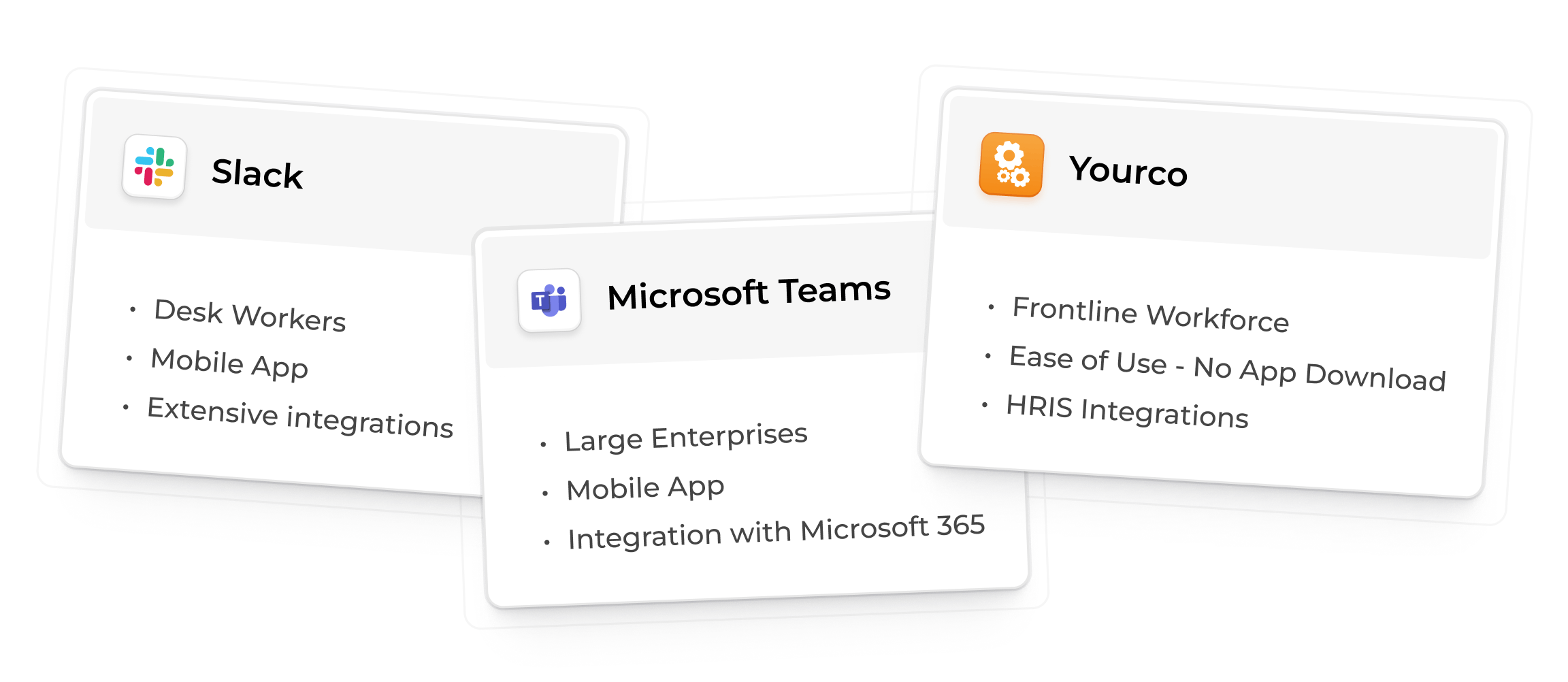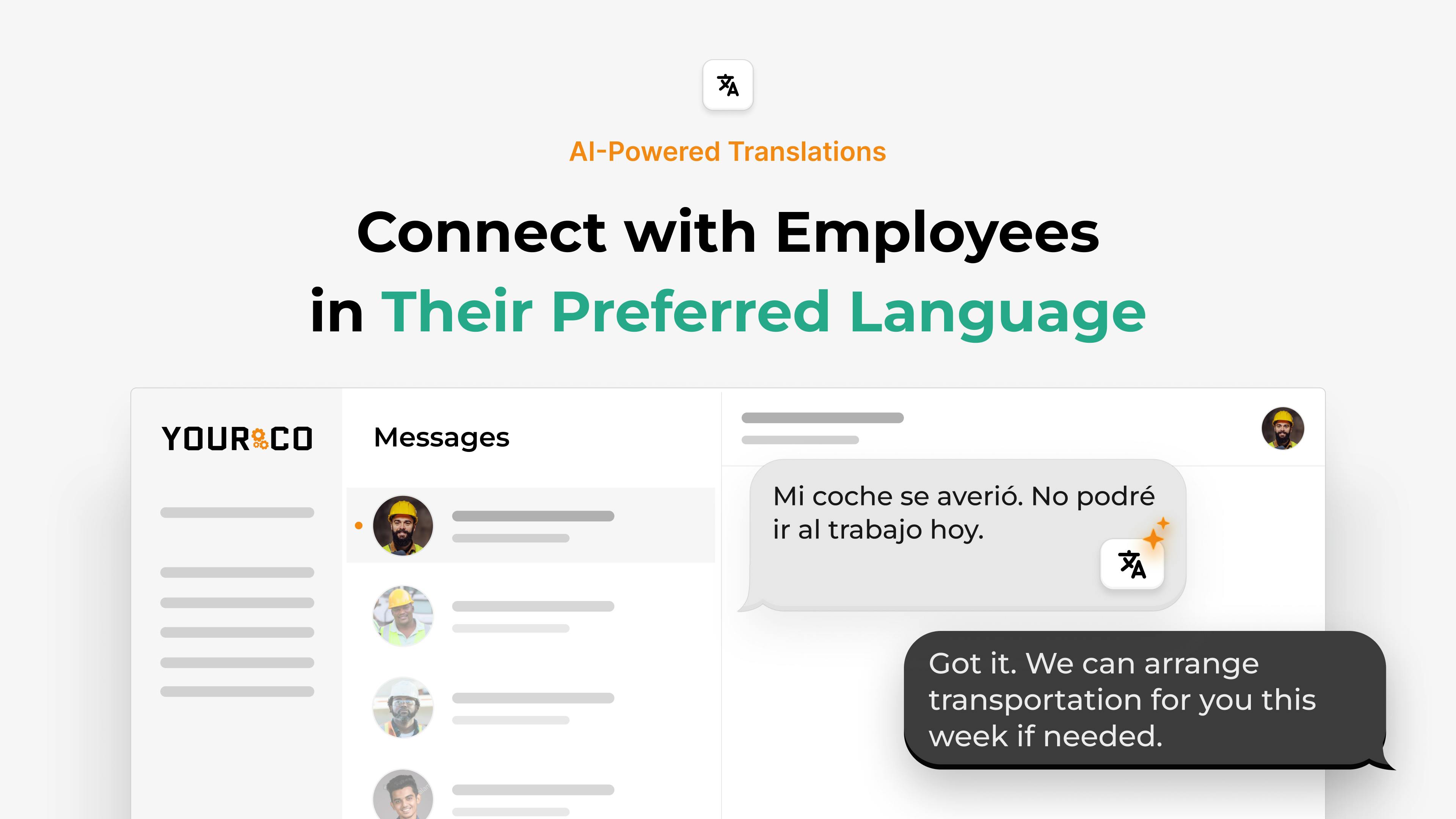What Are the Different Types of Employee Communication?


Communication gaps cost companies more than money. They create confusion, frustration, and disengaged workers who feel disconnected from their teams. For frontline workers in manufacturing, construction, retail, and healthcare, these gaps grow wider when traditional communication methods simply don't reach them.
The right communication approach changes everything. It boosts productivity, strengthens workplace culture, and keeps every employee informed regardless of where they work or what device they carry. Understanding the different types of workplace communication helps you choose methods that actually reach your entire team.
Understanding Employee Communication Types
Employee communication encompasses all information exchanges between workers and management, HR teams, or organizational leadership. This includes everything from daily operational updates to major company announcements, safety alerts, benefits communications, employee surveys, onboarding, and collecting referrals.
Workplace communication flows in multiple directions, each serving specific organizational needs:
- Vertical communication occurs between employees at different organizational levels, such as managers communicating with their teams or employees reaching out to supervisors with questions or concerns
- Horizontal communication happens among peers at similar levels, like team members collaborating on projects or sharing best practices across departments
- Downward communication flows from leadership to employees, including company announcements, policy updates, and strategic directives
- Upward communication enables employees to share feedback, suggestions, and concerns with management, creating two-way dialogue that builds trust and engagement
Communication also takes different delivery formats. Verbal communication relies on spoken words through conversations, phone calls, or video conferences. Non-verbal communication includes body language, facial expressions, and gestures that convey meaning beyond words. Written communication encompasses emails, text messages, newsletters, and policy documents. Visual communication uses images, videos, and infographics to convey information quickly and memorably. Listening involves receivers taking extra steps to ensure they fully understand the messages being communicated.
While these methods and directions matter, the tools you use determine whether messages actually reach your team, especially frontline workers who face unique access challenges.
How Different Communication Tools Reach Employees
Modern businesses rely on digital solutions to connect with their workforce. However, not all communication tools work equally well for every employee. Understanding how different platforms perform helps organizations choose methods that reach their entire team effectively.
Email: Limited Reach for Frontline Teams
Email remains a workplace staple for document sharing and formal communications. However, email presents significant challenges for frontline employee communication. Many frontline employees don't have company email addresses, and those without regular computer access may not maintain personal email accounts.
Email also suffers from low engagement rates, with only about 20% of messages being read promptly. For time-sensitive updates like shift changes or emergency alerts, email's delayed response times can create serious operational problems that affect safety and productivity.
Messaging Apps: Barriers for Non-Desk Workers
Applications like Slack, Microsoft Teams, WhatsApp, GroupMe, and RingCentral offer chat-based communication with file sharing and group messaging features. These employee communication apps are software programs that enable users to write, send, receive, and reply to messages, with many platforms supporting document collaboration and integration with other business tools.
While these platforms work well in office environments where employees have company-issued devices, reliable internet, and technical support, they create significant barriers for frontline workers. According to a survey reported in Forbes, 91% of respondents have a negative reaction to being forced to install an app on their phone, especially on personal devices.
The Fundamental Challenges with Mobile Apps
While messaging apps do offer faster response times than browser-based platforms and work well for office teams with company devices and reliable internet, these advantages don't overcome the fundamental accessibility barriers that prevent frontline workers from using them effectively.
- Smartphone requirement: Apps need modern smartphones capable of running current software, but approximately 10% of US adults don't own smartphones
- Storage space demands: Apps consume device storage that workers with older phones or limited space may not have available
- Internet dependency: Apps require Wi-Fi or strong cellular data connections, which aren't available in many work environments like underground facilities, remote construction sites, or rural warehouses
- Data costs: Apps consume employees' cellular data plans, forcing workers to pay out-of-pocket to stay connected with their employer
- Privacy concerns: Apps track user behavior and activity, which feels invasive when employers monitor personal devices
- Reliability issues: Even with strong connections, apps may fail due to glitches, software conflicts, or compatibility problems between device types
- Group chat drawbacks: Many apps default to group messaging that discloses employee contact information, creates notification overload, and generates off-topic conversations
Beyond download barriers, messaging apps create additional friction for non-desk teams. Apps require coordination that fails precisely when communication matters most: spotty connectivity in remote locations, during emergencies, or in areas with limited cellular coverage makes apps unreliable for time-sensitive workplace updates.
SMS Text Messaging: Universal Access for All Workers
Text messaging offers the most accessible communication method for reaching all employees. Over 5 billion people worldwide are active texters, and 98% of American adults own a cell phone capable of sending and receiving SMS messages. According to TrueList, 63% of cellphone users prefer texting over free messaging apps.
Text messages don't require app downloads, account setup, or internet connectivity, making them ideal for communicating with employees across diverse technical backgrounds and work environments. SMS works across all device types, from smartphones to basic flip phones, ensuring universal accessibility regardless of device age or capability.
Why SMS Succeeds Where Apps and Email Fail
- Zero friction: Workers use familiar technology they already know, with no downloads, passwords, or troubleshooting required
- No cost to employees: Text messaging to toll-free business numbers costs employees nothing; employers absorb all communication costs
- Superior reliability: Text messages work in areas where apps fail, including remote worksites, underground facilities, and rural areas with limited data coverage
- Exceptional engagement: Studies confirm that 95% of text messages are opened within three minutes, with overall read rates reaching 98%, dramatically higher than email's 20% open rate
Platforms like Yourco enhance SMS communication by providing dedicated company numbers, message logging for compliance, automatic translations in over 135 languages and dialects, and enterprise-grade security, all while maintaining the simplicity that makes texting so effective.
Professional SMS Platform Features
Professional SMS platforms combine the simplicity employees love with the management features businesses need:
- Dedicated company numbers keep personal contact information private and maintain professional boundaries
- Individual message delivery sends messages to groups but delivers them as one-on-one texts rather than group threads, eliminating notification overload and off-topic conversations
- Comprehensive message logging for compliance requirements and historical reference
- Sophisticated targeting that segments messages by department, location, shift, or role
- Two-way communication designed for workplace dialogue, not one-way marketing blasts
- HRIS integrations with 240+ systems that sync with existing workflows and eliminate manual data entry
For frontline workers especially, SMS solves communication gaps that other tools create. The difference becomes even more apparent when examining the specific challenges non-desk workers face in staying connected to their organizations.
Why Frontline Workers Need Different Communication Approaches
Frontline workers represent the majority of the global workforce, with approximately 80% of employees working outside traditional office settings. These non-desk workers, including retail employees, healthcare staff, construction teams, factory workers, delivery drivers, and agricultural workers, need reliable communication channels but often lack access to corporate email systems, company intranets, or desk-based technology. Despite their essential contributions to keeping industries running, frontline teams historically receive less investment in communication technology compared to their office-based counterparts.
Communication quality directly affects frontline workforce outcomes across multiple dimensions:
Operational Efficiency
Real-time information flow keeps frontline workers productive. Workers need immediate updates about shift changes, task assignments, safety protocols, and operational modifications. When communication delays occur, productivity suffers and coordination breaks down. Clear communication reduces misunderstandings, enables quicker decision-making, and helps teams respond rapidly to changing conditions.
Safety Compliance
Timely communication about safety procedures, hazard alerts, and emergency protocols can prevent accidents and save lives. In industries where workers face physical risks daily, employees who receive immediate safety notifications can take protective action before incidents escalate.
Employee Engagement and Retention
Making workers feel connected to their organization despite physical separation from corporate headquarters drives engagement. Engaged non-desk employees show higher retention rates, better performance, and stronger commitment to company goals. Communication fosters a sense of community and belonging among team members, even when they work across different shifts and locations.
Studies from Harvard Business Publishing show that employees in high-trust businesses have 106% more energy at work and are 50% more productive. According to Grammarly's 2024 research, 64% of business leaders report that effective communication has increased their team's productivity. When employees feel valued and understood through consistent communication, they're more likely to stay with their employer, making communication investment significantly more cost-effective than recruiting and training replacement workers.
How SMS Reaches Frontline Teams Effectively
SMS-based platforms transform how organizations connect with frontline teams by meeting workers where they are, on the devices they already carry and use daily. This approach eliminates technical barriers while providing the management capabilities organizations need.
Real-World SMS Applications
- Shift management and scheduling: Send shift reminders that reduce no-shows, communicate schedule changes instantly, and coordinate shift swaps without lengthy phone calls. For organizations managing multiple locations, SMS enables consistent communication across all sites while allowing local managers to customize messages for their specific teams.
- Emergency communications and safety alerts: Reach employees instantly during weather emergencies, facility evacuations, equipment hazards, or security incidents. Unlike email or app notifications that might go unread, text messages get immediate attention when timing matters most.
- Policy acknowledgments and compliance: Send policy updates, safety training reminders, and benefits enrollment deadlines through text, then automatically log employee responses for compliance records.
- Two-way feedback and engagement: Use SMS surveys and polls to gather employee input on workplace conditions, collect suggestions for improvements, and demonstrate that leadership values worker perspectives.
Multilingual and Geographic Accessibility
Text messages reach workers in their own language through SMS-based multilingual communication with AI-powered translation. Safety alerts, policy updates, and operational instructions automatically convert into each employee's preferred language, preventing miscommunication that could cause safety issues or compliance problems.
Workers can read messages in any of 135+ languages without you needing to hire translators or write separate versions for each language group. Employees receive messages in the language they prefer based on their profile, while managers write once and everyone gets the message in their language instantly.
Text messages also work in challenging environments where apps consistently fail. SMS reaches workers on remote construction sites with spotty cell service, in underground facilities like mines or parking structures, across rural agricultural operations, and inside warehouses where thick walls block internet signals. Wherever employees can get a basic cell signal, they can receive your messages.
Privacy and System Integration
Your employee contact information stays private with company-dedicated toll-free numbers, individual message delivery instead of group chats, and role-based permissions that let managers only see their own teams' conversations. Business texting keeps work and personal communication separate while ensuring managers access only what's relevant to their team.
Yourco connects with 240+ HRIS and payroll systems so information stays in sync automatically. Employee directories update, contact information stays current, and the system sends automatic reminders when benefits deadlines or training requirements come up. This cuts out manual data entry that wastes HR time and creates errors.
For organizations with high turnover or seasonal workforces, HRIS integration means your communication adjusts as team size changes. Employees added to your payroll system can receive messages immediately, and when workers leave, they're automatically removed, keeping your system secure throughout the employee lifecycle.
How SMS Reaches Frontline Teams Effectively
SMS-based platforms transform how organizations connect with frontline teams by meeting workers where they are, on the devices they already carry and use daily. This approach eliminates technical barriers while providing the management capabilities organizations need.
Real-World SMS Applications
- Shift management and scheduling: Send shift reminders that reduce no-shows, communicate schedule changes instantly, and coordinate shift swaps without lengthy phone calls. For organizations managing multiple locations, SMS enables consistent communication across all sites while allowing local managers to customize messages for their specific teams.
- Emergency communications and safety alerts: Reach employees instantly during weather emergencies, facility evacuations, equipment hazards, or security incidents. Unlike email or app notifications that might go unread, text messages get immediate attention when timing matters most.
- Policy acknowledgments and compliance: Send policy updates, safety training reminders, and benefits enrollment deadlines through text, then automatically log employee responses for compliance records.
- Two-way feedback and engagement: Use SMS surveys and polls to gather employee input on workplace conditions, collect suggestions for improvements, and demonstrate that leadership values worker perspectives.
Multilingual and Geographic Accessibility
Text messages reach workers in their own language through SMS-based multilingual communication with AI-powered translation. Safety alerts, policy updates, and operational instructions automatically convert into each employee's preferred language, preventing miscommunication that could cause safety issues or compliance problems.
Workers can read messages in any of 135+ languages without you needing to hire translators or write separate versions for each language group. Employees receive messages in the language they prefer based on their profile, while managers write once and everyone gets the message in their language instantly.
Text messages also work in challenging environments where apps consistently fail. SMS reaches workers on remote construction sites with spotty cell service, in underground facilities like mines or parking structures, across rural agricultural operations, and inside warehouses where thick walls block internet signals. Wherever employees can get a basic cell signal, they can receive your messages.
Privacy and System Integration
Your employee contact information stays private with company-dedicated toll-free numbers, individual message delivery instead of group chats, and role-based permissions that let managers only see their own teams' conversations. Business texting keeps work and personal communication separate while ensuring managers access only what's relevant to their team.
Yourco connects with 240+ HRIS and payroll systems so information stays in sync automatically. Employee directories update, contact information stays current, and the system sends automatic reminders when benefits deadlines or training requirements come up. This cuts out manual data entry that wastes HR time and creates errors.
For organizations with high turnover or seasonal workforces, HRIS integration means your communication adjusts as team size changes. Employees added to your payroll system can receive messages immediately, and when workers leave, they're automatically removed, keeping your system secure throughout the employee lifecycle.
Strengthen Your Workforce Communication with Yourco
Studies confirm that 95% of text messages are opened within three minutes, making SMS the most reliable channel for reaching employees when timing matters. Yourco transforms this natural behavior into a powerful business communication platform designed specifically for organizations with non-desk workforces.
With Yourco's SMS-based platform, you can:
- Send two-way communications between HR staff, managers, and employees using a dedicated company number that maintains professional boundaries while enabling personal interaction
- Manage all employee communications through a web-based dashboard accessible from any computer, tablet, or mobile device, giving managers flexibility to communicate from any location
- Maintain comprehensive records by logging and storing all conversations for compliance documentation, performance tracking, and historical reference
- Connect across language barriers using AI-powered translations that convert messages into each employee's preferred language, ensuring no one misses critical information due to language differences
- Reach every employee instantly during emergencies, shift changes, or urgent updates through reliable SMS delivery that works even when internet connectivity is unavailable
- Integrate with HRIS and payroll systems to eliminate manual processes and customize setup for each organization's unique structure, ensuring communication aligns with existing workflows
By leveraging SMS communication, organizations create more engaged workforces, improve safety outcomes, reduce communication delays, and build stronger relationships between management and frontline teams.
Ready to transform your employee communication? Try Yourco for free or schedule a demo to see how SMS-based communication can strengthen your team connections.
Frequently Asked Questions
What communication method works best for frontline workers?
SMS text messaging is the most effective communication method for frontline workers because it works on any mobile phone, doesn't require internet access or app downloads, and achieves 98% read rates. Unlike email or messaging apps, SMS reaches employees regardless of their technical comfort level or device type.
How can companies ensure all employees receive emergency communications?
SMS platforms provide the most reliable emergency communication because they work during internet outages and reach employees on any mobile device. Companies should implement SMS-based emergency alert systems that can instantly notify all workers, including those in remote locations or areas with poor internet connectivity.
What should companies keep in mind when texting employees?
When using text messaging for workplace communication, companies should focus on practical best practices. This includes asking employees for consent, using a dedicated business number instead of personal phones, keeping messages professional, and being mindful of after-hours communication rules. Many SMS platforms, such as Yourco, also provide built-in compliance support and message logging to simplify record-keeping and reduce risk.
How do you communicate with multilingual teams effectively?
SMS platforms with automatic translation capabilities solve multilingual communication challenges by instantly converting messages into each employee's preferred language. This ensures safety alerts, policy updates, and daily communications reach every worker in a language they understand, reducing miscommunication and improving compliance.
How is Yourco different from workplace messaging apps like Slack or Microsoft Teams?
Unlike traditional workplace apps that require downloads and internet connectivity, Yourco delivers messages as regular SMS texts that work on any phone without app installation. Managers access a web-based dashboard with enterprise features including AI-powered translations in 135+ languages and dialects, automatic compliance logging, 240+ HRIS integrations, and role-based permissions.
Yourco uses toll-free numbers so employees never pay for workplace communications, while messaging apps consume their cellular data. This makes Yourco ideal for frontline workers who need reliable communication from remote construction sites to warehouse floors without technical barriers or costs to employees.
What Are the 7Cs of Employee Communication in the Workplace?
The 7Cs of communication help teams share information clearly and reduce misunderstandings: clear, concise, complete, correct, courteous, concrete, and considerate. When messages follow these principles, employees understand what they need to do, why it matters, and how it affects their work. This approach helps frontline teams who rely on simple, direct updates that support fast decision-making throughout the day.
What are the key steps to help you become a more empathetic HR leader for non-desk staff?
To lead non-desk teams with empathy, spend time learning their daily realities, listen to concerns without judgment, and communicate in channels they can access easily during the workday. Show consistency by closing the loop when employees share feedback, and be visible on worksites so teams see you as a partner rather than a distant decision-maker. Small actions like acknowledging challenges, offering support, and following through on commitments build trust and demonstrate empathy in ways that matter to frontline employees.





